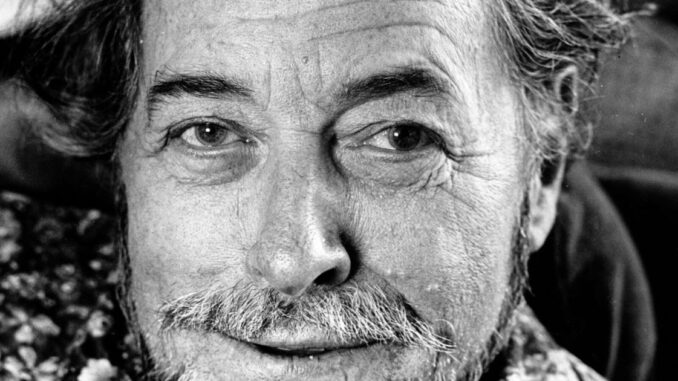
Well, thank goodness for 632 St. Peter St., that’s all I’m saying.
Had Tennessee Williams not taken an apartment in the three-story brick building with the iron lacework balconies in late 1946 and early ’47 while toiling away on what would become his most iconic play, he and his Remington Portable might not have been within earshot of the rambling, clanging clamor of the streetcar that once passed nearby on Royal Street.
And if he wouldn’t have been within earshot, he might not have been inspired to have Blanche DuBois ride said streetcar in the play’s opening scene.
And had Blanche not ridden it, Williams’ Pulitzer-winning “A Streetcar Named Desire” very well might have been published under its original title, the decidedly less poetic, less mysterious and less allegorical “The Poker Night.”
The former residence of Tennessee Williams on St. Peter St. in New Orleans.
That doesn’t mean Williams’ words would have been any less brilliant, but – yeah, just thank goodness for 632 S. Peter St., which is today one of the more noteworthy of New Orleans’ multitude of literary landmarks.
It’s also one of those that boasted an interesting history even before its Tennessee era.
The property on which the house sits can be traced to its original owner, Francois Girard – aka “Sieur Chamilly” – who received it as a land grant from the Company of the Indies in 1722. It passed through a variety of hands in the subsequent decades, including, by 1795, into those of Pierre Pedesclaux, the noted early city notary who would build a home on the site.
Other structures had previously occupied the property, but Pedesclaux’s house – a two-story brick building with a brick kitchen to go with it – appears to be the earliest described in any detail.
Fast-forward a couple or three decades to 1842, and the then-owner of the Pedesclaux house – the magnificently named Madame Augustine Eugenie de Lassize Avart – decided to tear it down and start anew.
To do it, she hired noted architect J.N.B. de Pouilly, who, in addition to his buildings, is known for designing some of the more elaborate tombs occupied by the city’s former elite.

This 1948 photos shows New Orleans Public Service Bus Operator Robert Cassagne tipping his hat in farewell to the city’s famed ‘Streetcar Named Desire.’ Buses were replacing the Desire Street trolleys.
Working with builder Ernest Goudchaux, de Pouilly came up with a quaint 2½-story brick townhouse with a single dormer window and a simple balcony on the second floor, according to the Historic New Orleans Collection’s Collins C. Diboll Vieux Carré Digital Survey.
That’s the structure occupying the site today.
It’s also the structure purchased in 1906 by the classically trained Italian artist Archie Perretti. Not only was it his home, it was his studio for 18 years, the place from which he made a name for himself in portraiture as well as for his creation of frescoes and religious paintings for local churches including St. Louis Cathedral, St. Patrick’s Church and St. Stephen’s Church.
At some point in the 20th century – after 1910 but before 1933, photos show – the dormer was taken out and a chunky brick third story added. That third story feels at odds with the rest of the building, lending the building an inelegant, top-heavy feel.
It’s got a skylight, though, and that skylight would prove notable during Williams’ occupation of an apartment at 632 St. Peter starting in October 1946.
“This place has so many memories,” Williams said of New Orleans during an interview with Rex Reed for a 1971 profile in Esquire magazine. “I came here in 1939 to write. I was heartbroken after my sister Rose’s confinement in a psychiatric hospital and I suffered a breakdown myself. In New Orleans I felt a freedom. I could catch my breath here.

A competitor gives it his all in the Stanley and Stella Shouting Contest in 2014. The Jackson Square contest is part of annual Tennessee Williams/New Orleans Literacy Festival, reenacting the unforgettable scene from ‘A Streetcar Named Desire.’
“See that bar over there? That used to be called Victor’s. I lived just around the corner in a large room atop of an old house where I worked under a skylight at a large refectory table writing ‘A Streetcar Named Desire.’”
Williams would tip his cap to the old place by giving Stanley and Stella Kowalski’s Elysian Fields home the same street number – 632 – in “Streetcar.”
In his “Memoirs,” published in 1975, Williams described that St. Peter Street home as “one of the loveliest apartments I’ve ever occupied,” once more remembering the skylight and the refectory table – although, interestingly, he placed that apartment on the second floor.
Presumably, he was using the European vernacular, where the ground floor is simply “the ground floor” and the one above – what Americans usually call the second floor – is referred to as the first. That would mean his “second floor” apartment was in that 20th century, third-floor addition, which only makes sense since a skylight would be expected on only the top floor.
It’s unclear what happened to the refectory table, but modern aerial images show a skylight still on the building’s northeast corner. So, if you stand on the opposite sidewalk and face 632 St. Peter – and perhaps crane your neck a little – you can see the third-story window (the one farther from Royal Street) that Williams would have presumably gazed through between sipping Brandy Alexanders at Victor’s.
By March 1947, Williams had moved on. On Dec. 3 of that same year, “Streetcar” opened on Broadway. The rest is literary history.
Thanks in no small part to 632 St. Peter St.
Williams is again in the spotlight this weekend, as the Tennessee Williams New Orleans Literary Festival continues in the French Quarter.
Sources: The Times-Picayune archives; The Historic New Orleans Collection’s Collins C. Diboll Vieux Carré Digital Survey; “The Booklover’s Guide to New Orleans,” by Susan Larson; 64parishes.org; Esquire magazine; “Memoirs,” by Tennessee Williams; Google Maps
Know of a New Orleans building worth profiling in this column, or just curious about one? Contact Mike Scott at moviegoermike@gmail.com.
A second ‘real’ Napoleon House? History makes it clear which is the imposter
Truth or just a good story? The ‘deliciously entrenched’ tale behind New Orleans’ Napoleon House

Leave a Reply